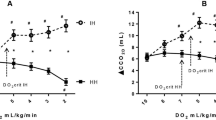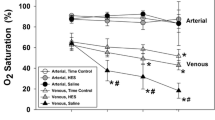Abstract
Objective
To assess local haemodynamic effects of raised tissue pressure per se and of arterial and venous pressure variations during raised tissue pressure, and to evaluate the vascular waterfall phenomenon.
Design
An isolated pump-perfused sympathectomised cat skeletal muscle enclosed in a plethysmograph.
Interventions
Hydrostatic capillary pressure (Pc), tissue volume alterations and blood flow wre recorded at various arterial (PA) or venous (PV) pressure levels at a raised tissue pressure (Ptissue). Total vascular resistance (Rtot) and its three consecutive sections, arterial resistance (Rart), venular resistance (Pvenule), and venous outflow orifice resistance (Rorifice), were recorded.
Results
Increase in Ptissue increased Pc due to a marked increase in Rorifice and unchanged Rart and, when Ptissue>PV by about 90% of the Ptissue increase. During the raised Ptissue, a PA increase (95 to 115 mmHg) increased Pc (by 3.1±1.1 mmHg) causing fluid filtration, and a PA decrease (95 to 75 mmHg) decreased Pc (by 2.4±0.5 mmHg) causing fluid absorption. Rart was unchanged, indicating impaired autoregulation. Increased PV had no haemodynamic effects when PV<Ptissue due to a gradual decrease in Rorifice towards zero when PV reached Ptissue. At PV>Ptissue blood flow and Pc increased gradually, causing fluid filtration.
Conclusions
Tissue volume is increased by raised an decreased by lowered PA, the latter may be of use to decrease ICP in the injured brain. The results indicate that PEEP or head elevation will not influence ICP from the venous side if CVP<ICP. Finally, the “vascular waterfall phenomenon” was rejected as Rorifice is a normal variable fluid resistance.
Similar content being viewed by others
References
Rosner MJ, Daughton S (1990) Cerebral perfusion pressure management in head injury. J Trauma 30:933–941
Asgeirsson B, Grände PO, Nordström CH (1994) A new therapy of post-trauma brain oedema based on haemodynamic principles for brain volume regulation. Intensive Care Med 20:260–267
Todd NV, Graham DI (1990) Blood-brain barrier damage in traumatic brain contusions. Acta Neurochir [Suppl] 51:296–299
Shapiro HM, Marshall LF (1978) Intracranial pressure responses to PEEP in head-injured patients. J Trauma 18:254–256
Luce JM, Huseby JS, Kirk W, Butler J (1982) Mechanism by which positive end-expiratory pressure increases cerebrospinal fluid pressure in dogs. J Appl Physiol 52:231–235
Rosner MJ, Coley IB (1986) Cerebral perfusion pressure, intracranial pressure, and head elevation. J Neurosurg 65:636–641
Kenning JA, Toutant SM, Saunders RL (1991) Upright patient positioning in the management of intracranial hypertension. Surg Neurol 15:148–152
Feldman Z, Kanter MJ, Robertson CS, Contant CF, Hayes C, Sheinberg MA, Villareal CA, Narayan RK, Grossman RG (1992) Effect of head elevation on intracranial pressure, cerebral perfusion pressure, and cerebral blood flow in head-injured patients. J Neurosurg 76:207–211
Cooper KR, Boswell PA, Choi SC (1985) Safe use of PEEP in patients with severe head injury. J Neurosurg 63:552–555
Hocroft JW, Link DP, Lantz BMT, Green JF, Weber CJ (1984) Venous return and the pneumatic antishock garment in hypovolemic baboons. J Trauma 24:921–1002
Nielsen HV (1991) Transmural pressures and tissue perfusion in man. Acta Physiol Scand 143 [Suppl 603]:85–92
Gosselin RE, Kaplow SM (1991) Venous waterfalls in coronary circulation. J Theoretical Biology 149:265–279
Yada K, Nagakawa Y, Tsurn M (1973) Circulatory disturbance of the venous system during experimental intracranial hypertension. J Neurosurg 39:723–729
Permutt S, Bromberger-Barnea B, Bane HN (1962) Alveolar pressure, pulmonary pressure, and the vascular waterfall. Med Thorac 19:239–260
Badeer HS, Hicks JW (1992) Hemodynamics of vascular “water-fall”: is the analogy justified? Respir Physiol 87:205–217
Grände PO (1992) New haemodynamic aspects on treatment of posttraumatic brain oedema Proceeding, Swedish Society of Anaesthesia and Intensive Care, Lund, vol 6; 2, pp 41–46
Grände PO, Borgström P, Mellander S (1979) On the nature of basal vascular tone in cat skeletal muscle and its dependence on transmural pressure stimuli. Acta Physiol Scand 107:365–376
Borgström P, Clementz L, Grände PO (1981) A servo controlled roller-pump for constant flow or constant pressure blood perfusion under normal pulsatile or non-pulsatile conditions. Acta Physiol Scand 112:437–442
Björnberg J, Grände PO, Maspers M, Mellander S (1988) Site of autoregulatory reactions in the vascular bed of cat skeletal muscle as determined with a new technique for segmental vascular resistance recordings. Acta Physiol Scand 133:199–210
Grände PO, Borgström P (1978) An electronic differential pressure flowmeter and a resistance meter for continuous measurement of vascular resistance. Acta Physiol Scand 102:224–230
Järhult J, Mellander S (1974) Autoregulation of hydrostatic capillary pressure in skeletal muscle during regional arterial hypo- and hypertension. Acta Physiol Scand 91:32–41
Wolff HG, Forbes HS (1928) The cerebral circulation. V. Observations of the pial circulation during changes in intracranial pressure. Arch Neurol Psychiatr 20:1035–1047
Cold GE, Taagehoj Jensen F (1978) Cerebral autoregulation in unconscious patients with brain injury. Acta Anaesth Scand 22: 270–280
Faraci FM, Baumbach GM, Heistad DD (1989) Myogenic mechanisms in the cerebral circulation. J Hypertension 7 [Suppl 4]:61–64
Heistad DD, Kontos HA (1983) Cerebral circulation. In: Shepard JT, Abboud FM (eds) Handbook of Physiology, vol 3. William & Wilkins, Baltimore, pp 137–182
Folkow B, Mellander S (1970) Measurements of capillary filtration coefficient and its use in studies of the control of capillary exchange. In: Crone C, Lassen NA (eds) Capillary permeability. The transfer of molecules and ions between capillary blood and tissue. Munksgaard, Copenhagen, pp 614–623
Cobbold A, Folkow B, Kjellmer I, Mellander S (1963) Nervous and local chemical control of pre-capillary sphincters in skeletal muscle as measured by changes in filtration coefficient. Acta Physiol Scand 57:180–192
Author information
Authors and Affiliations
Rights and permissions
About this article
Cite this article
Asgeirsson, B., Grände, P.O. Effects of arterial and venous pressure alterations on transcapillary fluid exchange during raised tissue pressure. Intensive Care Med 20, 567–572 (1994). https://doi.org/10.1007/BF01705723
Received:
Accepted:
Issue Date:
DOI: https://doi.org/10.1007/BF01705723




